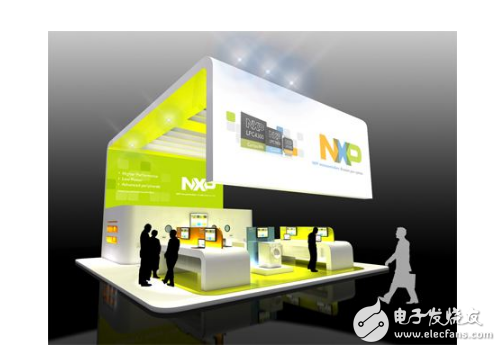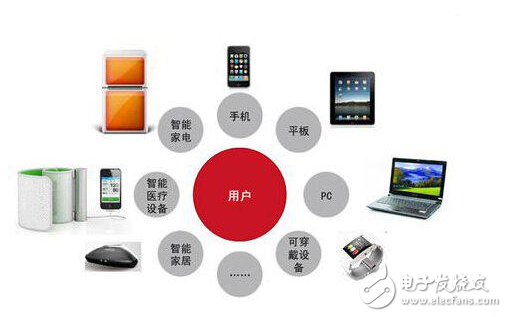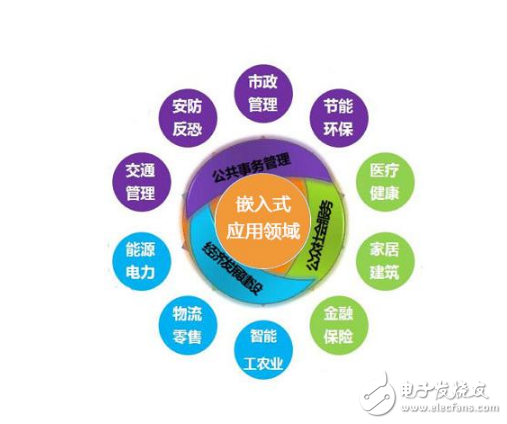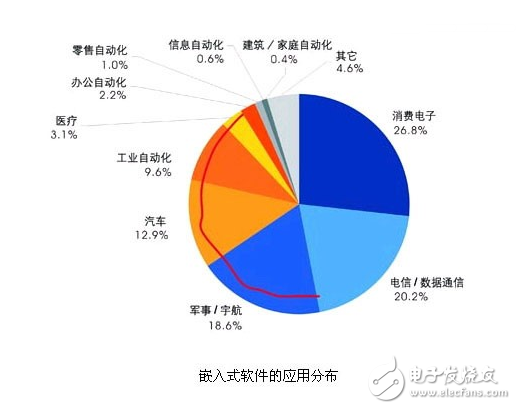An embedded system is a complete computer system that includes hardware and software. It is defined as: "Embedded systems are application-centric, based on computer technology, and can be tailored for application systems. A dedicated computer system with strict requirements for reliability, cost, size, and power consumption. The computer used in the embedded system is a dedicated microprocessor embedded in the controlled object, but the function is specialized than a general-purpose computer, and cannot be used by a general-purpose computer. A dedicated computer system with a specific design speed, high reliability and low comparative cost specially designed for a certain aspect.

The application prospects of embedded systems are very wide. People will be exposed to embedded products from time to time, from washing machines and refrigerators at home, to bicycles and cars as vehicles, to teleconferencing systems in the office. and many more. At home, in the office, in public places, people may use dozens or more of such embedded radio chips to make some electronic information devices and even electrical devices form a wireless network; in the car, on the road, people use such embedded The radio chip can realize remote office and remote control, and truly carry the network with you. Its application areas can include:
1. Traffic management: In terms of vehicle navigation, flow control, information monitoring and automotive services, embedded system technology has been widely used, embedded GPS module, GSM module mobile positioning terminal has been successfully used in various transportation industries. . At present, GPS equipment has entered the family of ordinary people from cutting-edge products. It only takes a few thousand dollars to find your location anytime, anywhere.
2. Home intelligent management system: remote automatic meter reading of water, electricity and gas meters, safety fire prevention, anti-theft system, embedded special control chip will replace traditional manual inspection and achieve higher, more accurate and safer performance.
3. POS network and e-commerce: public transportation contactless smart card issuance system, public telephone card issuance system, vending machine, and various intelligent ATM terminals will fully enter people's lives.
4. Environmental Engineering and Nature: real-time monitoring of hydrological data, flood control system and water and soil quality monitoring, dam safety, seismic monitoring network, real-time meteorological information network, water source and air pollution monitoring. In many areas with harsh environments and complex terrain, embedded systems will be unmanned.
5. Robots: The development of embedded chips will make the advantages of miniaturization and high intelligence more obvious, and will greatly reduce the price of robots, making them more widely used in industrial fields and services.
6. Industrial Control: Compared with other fields, electromechanical products can be said to be one of the most typical and widely used fields of embedded system applications. From the original single-chip microcomputer to the current industrial computer, SOC has a huge market in various mechanical and electrical products. Industrial equipment is the largest category of electromechanical products. In the current industrial control equipment, industrial computer is widely used. These industrial computers generally use industrial-grade processors and various equipments, among which X86 MPUs are the most. Industrial control requirements are often high, requiring a variety of equipment interfaces, in addition to real-time control, the device status, sensor information, etc. must be displayed on the display in real time. These 8-bit microcontrollers are unsatisfactory. Most of them used 16-bit processors. With the rapid development of processors, 32-bit and 64-bit processors have gradually replaced 16-bit processors, further improving system performance. . The system using PC104 bus is small, stable and reliable, and is favored by many users. However, these industrial computers are often DOS or Windows systems. Although they have embedded features, they cannot be called pure embedded systems. In addition, in terms of industrial controllers and device controllers, it is the world of various embedded processors. These controllers often use more than 16-bit processors, and various MCUs, Arm, Mips, and 68K series processors occupy a central position in the controller. These processors provide a wealth of interface bus resources through which data acquisition, data processing, communication, and display (displays typically connect LEDs or LCDs). Recently, Philips and ARM jointly launched a 32-bit RISC embedded controller for industrial control, using the most advanced 0.18 micron CMOS embedded flash processing technology, operating voltage can be as low as 1.2 volts, it can also reduce 25% to 30% Manufacturing costs are a cost-effective solution for end users in the industrial sector. Based on the Am188/186ES, i386EX, NEC V25, and Am586 (Elan SC520), the US TERN industrial controller uses the SUPERTASK real-time multitasking core for portable devices, wireless control devices, data acquisition devices, industrial control and industrial automation equipment. Other devices that require control processing.

7. The home appliance industry is another major industry for embedded applications. Nowadays, only the electric appliances of buttons and switches are obviously unable to meet the daily needs of people. The user interface, remote control and intelligent management of electrical appliances are the future development trend. According to statistics released by IDG, information appliances will grow five to ten times in the future. When China's traditional home appliance manufacturers transition to information appliances, the first challenge is the core operating system software development work. In terms of hardware, intelligent information control is not a very high requirement. At present, most embedded processors can meet hardware requirements. The real difficulty is how to make the software operating system small in capacity, high in stability and easy to develop. The Linux core can play a very good role as a bridge. As a cross-platform operating system, it can support two or thirty CPUs. At present, many home appliance chips have begun to do Linux platform migration. The Microsoft "Venus" program, which was registered in China in 1999, gave the Chinese people a concept of a digital home, and led the major appliance manufacturers to devote themselves to this revolution. Although they failed to succeed, they made information appliances popular. Nowadays, major manufacturers are still working hard to introduce chips for next-generation home appliance applications. Intel has developed an ARM CPU series called StrongARM for the information appliance industry. This series of CPUs does not need to integrate different chipsets like the X86 CPU. It can include all the functions you need in a chip, that is, the hardware system implements the concept of SOC. The company has successfully ported the world's smallest embedded operating system, QUARK, to the StrongARM series of chips. This is the first time that Linux, the graphical interface and some programs have been completely ported (the QUARKK kernel is only 143K). It will provide a powerful core operating system for information appliances. I believe that in the near future, digital smart families will come to us.
In these applications, emphasis can be placed on the application of control. In terms of remote home appliance control, in addition to the development of embedded systems that support TCP/IP, home appliance control protocols need to be developed and unified, which requires home appliance manufacturers to do. By the same token, all network-based remote control devices need to interface with the embedded system, which is then controlled by the embedded system and controlled over the network. Therefore, the development and discussion of embedded systems is of great significance.
Embedded system technology has a very broad application prospects, and its application areas can include:1. industrial control:
Industrial automation equipment based on embedded chips will have a great development. At present, there are a large number of 8, 16, and 32-bit embedded microcontrollers in the application. Networking is the main way to improve production efficiency, product quality, and reduce human resources. Industrial process control, digital machine tools, power systems, grid security, grid equipment monitoring, petrochemical systems. In the case of traditional industrial control products, the low-end type is often an 8-bit microcontroller. However, with the development of technology, 32-bit and 64-bit processors have gradually become the core of industrial control equipment, and will certainly achieve considerable development in the next few years.
2. Traffic management:
In terms of vehicle navigation, flow control, information monitoring and automotive services, embedded system technology has been widely used, embedded GPS module, GSM module mobile positioning terminal has been successfully used in various transportation industries. At present, GPS equipment has entered the family of ordinary people from cutting-edge products. It only takes a few thousand dollars to find your location anytime, anywhere.
3. Information appliances:
This will be called the largest application area of ​​embedded systems. The networking and intelligentization of refrigerators, air conditioners, etc. will lead people's lives into a new space. Even if you are not at home, you can remotely control via telephone line and network. Among these devices, embedded systems will be of great use.

4. Home Intelligence Management System:
Remote automatic meter reading of water, electricity and gas meters, safety fire prevention and anti-theft system, in which special control chips embedded will replace traditional manual inspection and achieve higher, more accurate and safer performance. Currently in the service field, such as remote ordering devices, etc. have already demonstrated the advantages of embedded systems.
5. POS network and e-commerce:
Contactless Smartcard (CSC) distribution system for public transportation, public telephone card issuance system, vending machine, and various intelligent ATM terminals will fully enter people's lives. When you hold a card, you can travel all over the world.
6. Environmental Engineering and Nature:
Real-time monitoring of hydrological data, flood control system and water and soil quality monitoring, dam safety, seismic monitoring network, real-time meteorological information network, water source and air pollution monitoring. In many areas with harsh environments and complex terrain, embedded systems will be unmanned. 7. robot:
The development of embedded chips will make the advantages of miniaturization and high intelligence more obvious, and at the same time, the price of robots will be greatly reduced, making it more widely used in industrial fields and services.
In these applications, emphasis can be placed on the application of control. In terms of remote home appliance control, in addition to the development of embedded systems that support TCP/IP, home appliance control protocols need to be developed and unified, which requires home appliance manufacturers to do. By the same token, all network-based remote control devices need to interface with the embedded system, which is then controlled by the embedded system and controlled over the network. Therefore, the development and discussion of embedded systems is of great significance.
Application of embedded systems in electromechanical productsCompared with other fields, electromechanical products can be said to be one of the most typical and widely used fields of embedded system applications. From the original single-chip microcomputer to the current industrial computer, SOC has a huge market in various mechanical and electrical products.
Industrial equipment is the largest category of electromechanical products. In the current industrial control equipment, industrial computer is widely used. These industrial computers generally use industrial-grade processors and various equipments, among which X86 MPUs are the most. Industrial control requirements are often high, requiring a variety of equipment interfaces, in addition to real-time control, the device status, sensor information, etc. must be displayed on the display in real time. These 8-bit microcontrollers are unsatisfactory. Most of them used 16-bit processors. With the rapid development of processors, 32-bit and 64-bit processors have gradually replaced 16-bit processors, further improving system performance. . The system using PC104 bus is small, stable and reliable, and is favored by many users. However, these industrial computers are often DOS or Windows systems. Although they have embedded features, they cannot be called pure embedded systems. In addition, in terms of industrial controllers and device controllers, it is the world of various embedded processors. These controllers often use more than 16-bit processors, and various MCUs, Arm, Mips, and 68K series processors occupy a central position in the controller. These processors provide a wealth of interface bus resources through which data acquisition, data processing, communication, and display (displays typically connect LEDs or LCDs). Recently, Philips and ARM jointly launched a 32-bit RISC embedded controller for industrial control, using the most advanced 0.18 micron CMOS embedded flash processing technology, operating voltage can be as low as 1.2 volts, it can also reduce 25% to 30% Manufacturing costs are a cost-effective solution for end users in the industrial sector. Based on the Am188/186ES, i386EX, NEC V25, and Am586 (Elan SC520), the US TERN industrial controller uses the SUPERTASK real-time multitasking core for portable devices, wireless control devices, data acquisition devices, industrial control and industrial automation equipment. Other devices that require control processing.

The home appliance industry is another big industry for embedded applications. Of course, our traditional TVs and refrigerators also have processors embedded in them, but these processors are only used in control applications. Nowadays, only the electric appliances of buttons and switches are obviously unable to meet the daily needs of people. The user interface, remote control, and intelligent management of electrical appliances are the future development trends. According to statistics released by IDG, information appliances will grow five to ten times in the future. When China's traditional home appliance manufacturers transition to information appliances, the first challenge is the core operating system software development work. In terms of hardware, intelligent information control is not a very high requirement. At present, most embedded processors can meet hardware requirements. The real difficulty is how to make the software operating system small in capacity, high in stability and easy to develop. The Linux core can play a very good role as a bridge. As a cross-platform operating system, it can support two or thirty CPUs. At present, many home appliance chips have begun to do Linux platform migration. The Microsoft "Venus" program, which was registered in China in 1999, gave the Chinese people a concept of a digital home, and led the major appliance manufacturers to devote themselves to this revolution. Although they failed to succeed, they made information appliances popular. Nowadays, major manufacturers are still working hard to introduce chips for next-generation home appliance applications. Intel has developed an ARM CPU series called StrongARM for the information appliance industry. This series of CPUs does not need to integrate different chipsets like the X86 CPU. It can include all the functions you need in a chip, that is, the hardware system implements the concept of SOC. The company has successfully ported the world's smallest embedded operating system, QUARK, to the StrongARM series of chips. This is the first time that Linux, the graphical interface and some programs have been completely ported (the QUARKK kernel is only 143K). It will provide a powerful core operating system for information appliances. I believe that in the near future, digital smart families will come to us.

The development of robotics has always been closely linked to the development of embedded systems. The earliest robot technology was the numerical control technology proposed by MIT in the 1950s. At that time, it was far from the chip level, and it was just a simple NAND logic circuit. Since then, due to the slow development of processor and intelligent control theory, from the 1950s to the early 1970s, robotics has not been fully developed. After the mid-1970s, due to the development of intelligent theory and the emergence of MCUs, robots have gradually become research hotspots and have achieved considerable development. Recently, due to the high development of embedded processors, robots have also presented new trends from hardware to software. For example, the Rover is a typical example. The $1 billion technology-intensive mobile robot uses the Vxworks embedded operating system from Wind River, Inc., and can work independently without contacting the Earth. The "Sorgen" Mars rover launched in the United States in 1997 has a robot that can collect various conditions on Mars and send images from Mars back to the ground command center through the camera. This Mars car has been working independently on Mars for three months, fully demonstrating the high reliability of the Vxworks system. The intelligent machine pet represented by Sony's robot dog can use only 8-bit AVR, 51 MCU or 16-bit DSP to control the steering gear and perform image processing to create toys that are loved by people. Let us Can't help but marvel at the power of the embedded processor. Recently, 32-bit processors, Windows CE and other 32-bit embedded operating systems are prevalent, so that manipulating a robot only needs to obtain the information of the remote robot on the handheld PDA, and control the operation of the robot through wireless communication, compared with the traditional industrial computer. More than light, more convenient. As embedded controllers become more and more miniaturized and functional, micro-robots and special robots will also have greater development opportunities.
Valve-regulated Sealed Lead Acid Battery
Long Time Life Battery,Uninterruptible Power System,Thin Plate Technology Battery,Sealed Lead Acid Battery
Wolong Electric Group Zhejiang Dengta Power Source Co.,Ltd , https://www.wldtbattery.com